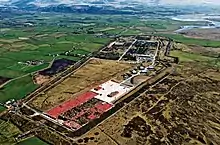Low Level Waste Repository
The Low Level Waste Repository is the UK's central long-term store for low-level radioactive waste located on the West Cumbrian coast near Drigg village and opened in 1959. It is a subsidiary of the Nuclear Decommissioning Authority.

Function
The site stores low level radioactive waste from Sellafield, MoD sites, nuclear power stations, hospitals, universities, medical companies and the oil industry. The site, which was opened in 1959 by the United Kingdom Atomic Energy Authority,[1] covers about 270 acres (110 ha) on the site of the former Royal Ordnance Factory (ROF Drigg). [2]
Ownership and management
The Nuclear Decommissioning Authority (NDA), who owned LLWR at the time, announced in March 2008 that UK Nuclear Waste Management Ltd (a consortium led by the Washington Division of URS Corporation and including Studsvik UK, AREVA-NC and Serco Assurance) had been awarded the contract for the management and operation of the Low Level Waste Repository.[3]
This arrangement ceased when the LLWR was brought back under direct public management when it became a subsidiary of the NDA in July 2021.[4] In 2022 LLWR was merged with the NDA's Integrated Waste Management Programme to form a division called Nuclear Waste Services.[5]
Continued use
In early 2008, Cumbria County Council granted permission for a new vault, Vault 9, to be built to accommodate about 700 ISO steel containers per year and be able to hold 5,500 ISO steel containers in total, giving an operational life of about eight years.[6] The vault opened for use in 2010.[7] In 2015, a report from the Environment Agency acknowledged that the site would be disrupted in the future by coastal erosion and flooding, and placed requirements on LLWR Ltd to maintain a programme of coastal monitoring and to keep up-to-date with research and development on the long-term effects of climate change.[8][9]
References
- "Low Level Waste Repository". NDA. Archived from the original on 21 April 2014. Retrieved 20 April 2014.
- Jason Nisse (19 June 2005). "BNFL told to combat threat of nuclear contamination on Cumbrian beaches". The Independent.
- "Nuclear waste site deal is struck". BBC News. 31 March 2008.
- "Low Level Waste Repository becomes a subsidiary of the NDA". GOV.UK. Retrieved 24 August 2023.
- "UK launches consolidated radwaste organisation". World Nuclear News. 31 January 2022. Retrieved 2 February 2022.
- "Planning approval granted for new low level radioactive waste repository near Drigg". Cumbria County Council. 22 January 2008. Archived from the original on 28 September 2011.
- "Cumbria store for low-level nuclear by-products opens". BBC News. 29 July 2010.
- Edwards, Rob (20 April 2014). "Cumbrian nuclear dump 'virtually certain' to be eroded by rising sea levels". The Guardian. Retrieved 20 April 2014.
- Environment Agency, Decision Document: Low Level Waste Repository, October 2015